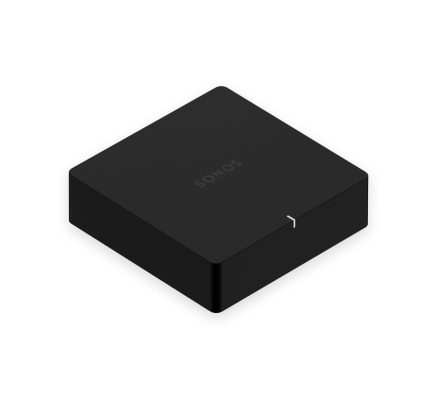

Use an Ethernet cable to connect to a router, computer, or additional network device like a network-attached storage (NAS) device (optional).
LED indicators:
Flashing Green (network activity)
Yellow (link connection)
12V trigger
Use a stereo cable or a 3.5mm to 3.5mm cable to wake your third-party amplifier whenever Sonos starts playing audio.
Note: Read the guide that came with your amplifier for details on the use of 12V trigger input.
AC power (Mains) input
Use only the included power supply (using a third-party power supply will void your warranty).
Analog audio in
Use a standard RCA audio cable (included) to connect Port’s analog audio inputs to the audio outputs on another device, like a pre-amplified turntable.
Analog audio out
Use a standard RCA audio cable (included) to connect Port’s analog audio outputs to the audio inputs on your amplified audio component.
Digital audio out
Use a digital coaxial cable to connect Port’s coaxial digital audio output to the audio inputs on your amplified audio component.
You can place Port just about anywhere—in an electronics rack, on a shelf, or on a credenza with your audio/video receiver (AVR).
Rack mounted
Port fits perfectly in any electronics rack using a third-party shelf. You can fit 3 units across a standard rack and take up only 1 rack unit of vertical space.
Placed on a credenza
Connect the power cord and plug in your Port.
Connect Port to your audio equipment.
For powered speakers:
For an audio/video receiver (AVR) or amplifier:
For a computer:
Download the app from the app store on your mobile device if you don't already have it. You’ll use it to set up and control your Sonos system.
Connect an audio device, like a projector, CD player, or turntable (with a built-in phono preamp), to any Sonos product that has a line-in port (Era 300, Era 100, Amp, Port, or Five). Then go to > Line-In to select the source and start playback.
Note: Era 300 and Era 100 require a Sonos Line-In or Combo Adapter (sold separately). Other products may require a different type of line-in adapter depending on your audio source.
Control volume from your AVR or amplifier (Fixed line-out level)
Set Port’s line-out level to Fixed if you want to control the volume exclusively from your AVR or amplifier. You won’t be able to use the Sonos app to adjust the volume or equalization settings.
Control the volume from Sonos (Variable line-out level)
When Port’s line-out level is set to Variable, you can use the Sonos app to adjust the volume.
Use Sonos to control the volume on your home theater or amplifier
When Port’s line-out level is set to Pass-Through, Port stays at a fixed volume and sends volume commands to your amplifier. You can control volume using the Sonos app, a universal remote, or your voice if you have a voice assistant enabled.
Note: Make sure your amplifier supports Pass-Through. If you set the line-out level to Pass-Through and your amplifier doesn’t support it, you won’t be able to control the volume.
Port plays audio in stereo by default. You can change the sound settings for the room associated with the Port so it plays in two mono channels when playing music.